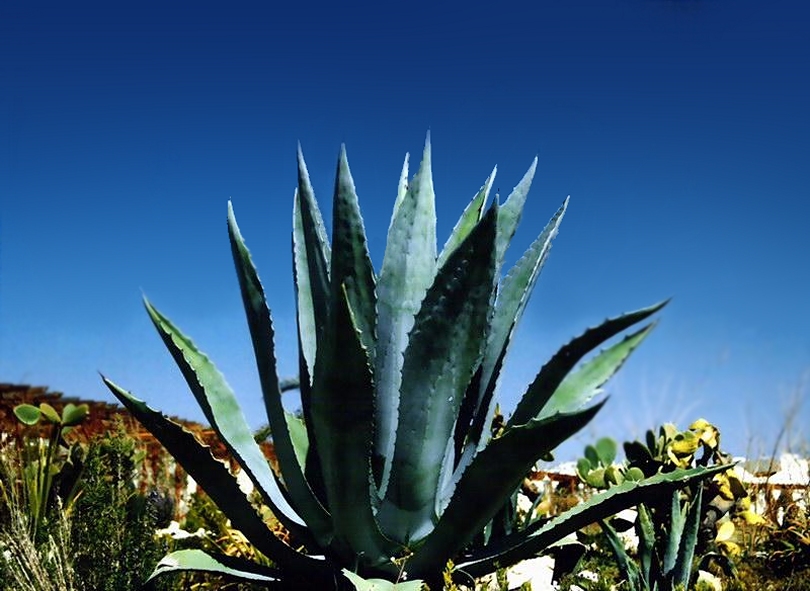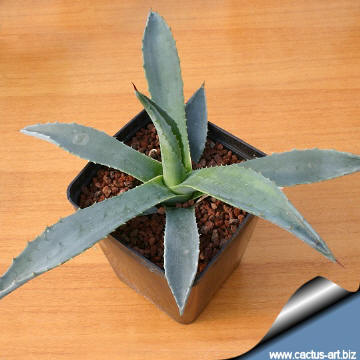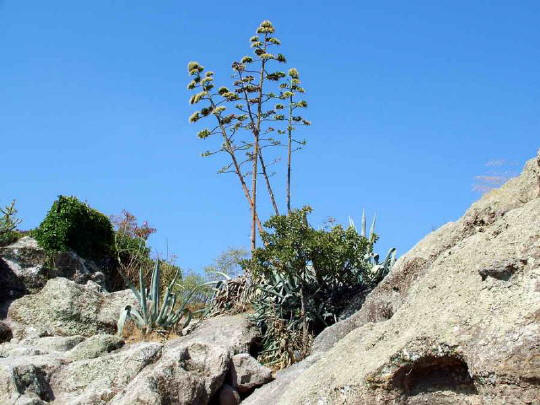|
|
|

Photo &
© copyright
by Süleyman Demir Turkey
Home page:
http://community.webshots.com/user/demir165
A. americana with its dramatic powdery blue
leaves is undoubtably the most tolerant of all the Agaves which explains
its wide distribution.
|
 |
Description:
Solitary or slowly
clumping large leaf succulent with a basal rosette (up to 4 m
wide)
Leaves: Thick and massive grey-blue up to 150-200 cm long and 25
cm wide, and have sharp spines on the margins and tips. The margin
spines are recurved like fishhooks and the tip spines can be more than
2,5 cm long.
Flowers: The inflorescence of the Agave americana is branched can
reach epic proportions, soaring 3 -7 m or more, and bears large (6-10cm)
yellow-green flowers. Inflorescences look like asparagus spears as they
grow.
The "Century plant" doesn't
really take a century to bloom, but it does take 10 years or so in warm
regions and as much as 60 years in colder climates. It dies after
blooming (a condition called
monocarpic), but produces offsets or "pups"
throughout its life and these remain to continue the lineage.
|
|
Cultivation:
Specimens even survive in pots or in the ground in the wet winters of
the south coast of England. At the other extreme it may be seen planted
out in southern Arizona and Texas. They are usually cultivated outdoors
in rock gardens, in cactus and succulent gardens, in Mediterranean-style
landscapes, in borders, or as a specimen. Need full sun and a very
well-drained, slightly acidic, sandy or gravely soil. As an ornamental
it is also grown in containers where it stays much smaller than
its outdoor brethren. Agave americana is theoretically hardy to
-9° C , particularly when dry and it is
best to avoid severe
freezing temperatures. Keep it in a cool, frost-free area in winter
and put it out on the balcony or patio in summer. The Agave americana
grows fairly fast in summer if provided with copious water but allows to
dry thoroughly before watering again. During the winter months, one
should only water enough to keep the leaves from shriveling. They do
well in full sun or a lightly shaded area.
Warning: It can get very large, and it is armed with needle-sharp
spines.
|
Use:
-
Scenography:
These striking plants are wonderful when used for accent or simply to
provide some all year round foliage and often used in a pot as a patio
plant, can be moved around to change the scenery or position to give
more shelter
- Medicine:
The sap of century
plant is used as a diuretic and a laxative. The juice of the leaves is
applied to bruises and taken internally for indigestion, flatulence,
constipation, jaundice and dysentery
- Food:
The flower stalk and
heart of century plant are sweet and can be roasted and eaten. The
seeds are ground into flour to make bread and to use as a thickener
for soups.
- Alcoholic drinks:
If the flower stem is cut without flowering, a sweet liquid called
agua miel ("honey water") gathers in the heart of the plant. This may
be fermented to produce a beer-like drink called pulque, which may
then be distilled to produce mezcal.
- Fibres:
The leaves also yield fibres, known as pita, which are suitable for
making rope, matting, coarse cloth and are used for embroidery of
leather in a technique known as piteado.
|
|
Advertising
|
|
|
|
|
Family: Agavaceae
Scientific Name: Agave americana L.
Common name: Century plant, American aloe
Synonims: Agave ramosa Moench.
Origin: This species is probably the Agave
most commonly grown as an ornamental plant cultivated worldwide. Because
of extensive propagation, its exact origin is uncertain although it
probably came from arid areas of Mexico. It also has escaped cultivation
and become established in the Mediterranean region of Africa and Europe.
Etymology: In ancient Greek mythology "Agave"
was the daughter of Cadmus, the king and founder of the city of
Thebes, and of the goddess Harmonia. She married Echion,
one of the five spartoi, and was the mother of Pentheus, a king
of Thebes. She was a Maenad, a follower of Dionysus.
Synonyms:
- Agave ramosa Moench
- Agave americana var. theometel,
- Agave theometel,
- Agave spectabilis,
- Agave altissima,
- Agave rasconensis,
- Agave milleri,
- Agave communis,
- Agave complicata,
- Agave felina,
- Agave fuerstenbergii,
- Agave gracilispina,
- Agave ingens,
- Agave melliflua
|
|
|
|

Photo &
© copyright
by Süleyman Demir Turkey
The inflorescence of the Agave
americana can reach epic proportions, soaring up to 8 m.
Propagation: Exclusively by
suckers which often are found growing around the base of the
plant, Remove the basal suckers (if available) in spring or summer
and let the cuttings dry for a few days before inserting in compost.
Photo of conspecific taxa, varieties, forms and
cultivars of Agave americana.


|
|